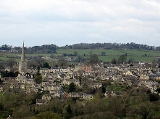
Painswick
Encyclopedia
Painswick is a small town in Gloucestershire
, England
. Originally the town grew on the wool trade, but it is now best known for its parish church's yew
trees and the local Rococo
Garden. The town is mainly constructed of locally quarried Cotswold stone
. Many of the buildings feature south-facing attic rooms once used as weavers'
workshops.
Geographically Painswick is situated on a hill in the Stroud district
, overlooking the Stroud valleys. Its narrow streets and traditional architecture make it the epitome of the English village. There is a golf course near the Painswick Beacon.
. This can be seen in the defensive earthworks atop nearby Painswick Beacon, which has wide views across the Severn Vale. The local monastery
, Prinknash Abbey
, was established as long ago as the 11th century.
During the first English civil war
(1642–1645) Gloucester
was a Parliamentarian stronghold of some strategic importance. Consequently it was surrounded by forces loyal to the King. After the siege of Gloucester
was broken on 5 September 1643, the Royalist
army, which had been surrounding the city, encamped overnight at Painswick. Some damage was caused by the troops and a scar from two small cannonballs
can still be seen on the tower of St. Mary's parish church
.
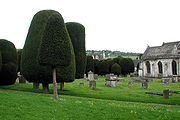 The Church of England parish church
The Church of England parish church
of Saint Mary
is a Grade I listed building. A priest in Painswick is noted in the Domesday Book
and so it is assumed that there was also a church here at that time. Evidence suggests that it was built between 1042 and 1066 by Ernesi, a rich Anglo Saxon thegn
who was then Lord of the Manor
.
After the Norman conquest the Lordship passed to the family of de Laci
, the patron saint of which was Saint Peter
. In 1377 the chapel at the north side of the church was rebuilt and dedicated to St. Peter. This is the oldest part of the church. Shortly afterwards the north aisle was added.
By this time the de Laci family had given the living to the Prior and Canons of Llanthony Priory
who had spiritual oversight of the parish until the Reformation
.
The nave
and tower were built about 1480 and by 1550 the sanctuary has taken its present form. The spire
was not added until 1632. The church remained in this form until the English Civil War
when it was occupied by Parliamentarians in 1644. The Royalists recaptured the town, however, after severe fighting. Bullet and cannon shot marks remain on the church tower to this day. The church was greatly damaged by fire.
In 1657 a gallery was added to the north aisle. In 1740 the south aisle was built with a gallery above. A west gallery was added in 1840. In 1877 the church was restored by public subscription. The font
dates from 1661 and replaced one destroyed during the Civil War. The Royal Arms over the entrance door are those of William IV.
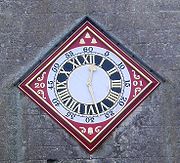 The imposing tomb was occupied by three different families and suffered in the fire of 1644. The First World War screen was carved by a Belgian refugee and lists all those from Painswick who served and the names of those who died in gold.
The imposing tomb was occupied by three different families and suffered in the fire of 1644. The First World War screen was carved by a Belgian refugee and lists all those from Painswick who served and the names of those who died in gold.
The organ was originally built in the 18th century by Sneltzer but only the casing remains. The present instrument was installed by Nicholson of Worcester
.
A bell ringers' society was formed in 1686 and the ringers are still known as the “Ancient Society of Painswick Youths”. Before 1731 there were eight bells, but the ring was augmented in 1732 and in 1819 by four further bells. In 1986 to celebrate the tercentenary of the society a thirteenth bell was added and the clock face restored. In 1993 the addition of an extra treble bell, made possible by a generous donation, completed the present ring of fourteen bells.
In the churchyard
Painswick has a unique collection of chest tombs and monuments from the early 17th century onwards, carved in local stone by local craftsmen. The oldest tomb, with fossils on the top, is of William Loveday, Yeoman
, dated 1623. Clifton-Taylor
describes the churchyard, with its tombs and yews, as "the grandest churchyard in England".
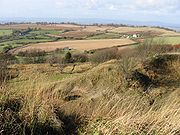 On the nearest Sunday to 19 September the ceremony known as "clipping the church
On the nearest Sunday to 19 September the ceremony known as "clipping the church
" takes place. Local children wear flowers in their hair, join hands and embrace St. Mary's parish church.
Folklore
holds that the churchyard will never have more than 99 yew trees and that should a 100th grow the Devil
would pull it out. According to the V&A
a count of the trees showed there to be 103. The plan of the churchyard included in the church's own public leaflet shows 100.
While Royalists were encamped in Painswick, tradition has it that King Charles went up to the Beacon and, seeing the beautiful valley to the east said "This must be Paradise". Since then that valley, and the hamlet on its western side to the north of Painswick have been called Paradise.
During the 18th century a group of gentry, led by Benjamin Hyett, organised an annual procession dedicated to Pan
, during which a statue of the deity was held aloft, and people shouted 'Highgates! Highgates!". The tradition died out in the 1830s, but was revived in 1885 by the new vicar, W. H. Seddon, who mistakenly believed that the festival had been ancient in origin. Seddon's successor, however, was less appreciative of the pagan festival and put an end to it in 1950, when he had Pan's statue buried, although it was later dug up and placed within the grounds of Painswick House.
Bow Wow Sauce
, a sauce to be served with roast meats, was developed in Painswick.
for children aged 4 to 11 with fewer than 150 pupils. In the key stage 2 results for 2008 91% of children achieved or exceeded level 4 in English and science and 84% did so in maths. These results are slightly higher than the county averages of 86%, 82% and 91% in English, maths and science respectively.
Chapel on New Street was built in 1806 by the Wesleyan
Methodists, but was sold to the Baptists in 1831. The premises are now used by an estate agent.
The Chapel of Our Lady and St. Teresa on Friday Street opened for Roman Catholic worship on 4 August 1934. On 15 June 1941 it was almost completely destroyed by a German bomb. It was subsequently restored and somewhat enlarged and is still used on a weekly basis.
The Friends
' Meeting House on Vicarage Street, was built in 1705/6, refurbished in 1793/4 and closed in 1894. It re-opened in 1952. The burial ground, to the north of Dell Farm, has been in use since 1658.
Ebenezer Chapel, formerly Primitive Methodist, in Bisley Street was built in 1854.
The United Reformed Church
in Gloucester Street was built as a Congregational
chapel in 1803, was extensively altered in 1892 and was renamed "The Cornelius Winter Memorial Chapel".
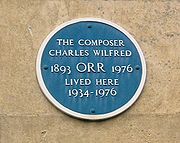
Gloucestershire
Gloucestershire is a county in South West England. The county comprises part of the Cotswold Hills, part of the flat fertile valley of the River Severn, and the entire Forest of Dean....
, England
England
England is a country that is part of the United Kingdom. It shares land borders with Scotland to the north and Wales to the west; the Irish Sea is to the north west, the Celtic Sea to the south west, with the North Sea to the east and the English Channel to the south separating it from continental...
. Originally the town grew on the wool trade, but it is now best known for its parish church's yew
Taxaceae
The family Taxaceae, commonly called the yew family, includes three genera and about 7 to 12 species of coniferous plants, or in other interpretations , six genera and about 30 species....
trees and the local Rococo
Rococo
Rococo , also referred to as "Late Baroque", is an 18th-century style which developed as Baroque artists gave up their symmetry and became increasingly ornate, florid, and playful...
Garden. The town is mainly constructed of locally quarried Cotswold stone
Cotswold stone
Cotswold stone is a yellow oolitic limestone quarried in many places in the Cotswold Hills in the south midlands of England. When weathered, the colour of buildings made or faced with this stone is often described as 'honey' or 'golden'....
. Many of the buildings feature south-facing attic rooms once used as weavers'
Weaving
Weaving is a method of fabric production in which two distinct sets of yarns or threads are interlaced at right angles to form a fabric or cloth. The other methods are knitting, lace making and felting. The longitudinal threads are called the warp and the lateral threads are the weft or filling...
workshops.
Geographically Painswick is situated on a hill in the Stroud district
Stroud (district)
Stroud is a local government district in Gloucestershire, England. It is named after its largest town, Stroud, and has its administrative headquarters in Ebley Mill, in the Ebley area on the outskirts of the town.thumb |left |Ebley Mill...
, overlooking the Stroud valleys. Its narrow streets and traditional architecture make it the epitome of the English village. There is a golf course near the Painswick Beacon.
History
There is evidence of settlement in the area as long ago as the Iron AgeBritish Iron Age
The British Iron Age is a conventional name used in the archaeology of Great Britain, referring to the prehistoric and protohistoric phases of the Iron-Age culture of the main island and the smaller islands, typically excluding prehistoric Ireland, and which had an independent Iron Age culture of...
. This can be seen in the defensive earthworks atop nearby Painswick Beacon, which has wide views across the Severn Vale. The local monastery
Monastery
Monastery denotes the building, or complex of buildings, that houses a room reserved for prayer as well as the domestic quarters and workplace of monastics, whether monks or nuns, and whether living in community or alone .Monasteries may vary greatly in size – a small dwelling accommodating only...
, Prinknash Abbey
Prinknash Abbey
Prinknash Abbey is a Roman Catholic Benedictine monastery situated in the Vale of Gloucester in the Diocese of Clifton, near the village of Cranham....
, was established as long ago as the 11th century.
During the first English civil war
English Civil War
The English Civil War was a series of armed conflicts and political machinations between Parliamentarians and Royalists...
(1642–1645) Gloucester
Gloucester
Gloucester is a city, district and county town of Gloucestershire in the South West region of England. Gloucester lies close to the Welsh border, and on the River Severn, approximately north-east of Bristol, and south-southwest of Birmingham....
was a Parliamentarian stronghold of some strategic importance. Consequently it was surrounded by forces loyal to the King. After the siege of Gloucester
Siege of Gloucester
The Siege of Gloucester was an engagement in the First English Civil War. It took place between August 3 and September 5, 1643, between the defending Parliamentarian garrison of Gloucester and the besieging army of King Charles I. The siege ended with the arrival of a relieving Parliamentarian army...
was broken on 5 September 1643, the Royalist
Cavalier
Cavalier was the name used by Parliamentarians for a Royalist supporter of King Charles I and son Charles II during the English Civil War, the Interregnum, and the Restoration...
army, which had been surrounding the city, encamped overnight at Painswick. Some damage was caused by the troops and a scar from two small cannonballs
Round shot
Round shot is a solid projectile without explosive charge, fired from a cannon. As the name implies, round shot is spherical; its diameter is slightly less than the bore of the gun it is fired from.Round shot was made in early times from dressed stone, but by the 17th century, from iron...
can still be seen on the tower of St. Mary's parish church
Parish church
A parish church , in Christianity, is the church which acts as the religious centre of a parish, the basic administrative unit of episcopal churches....
.
Parish Church

Church of England parish church
A parish church in the Church of England is the church which acts as the religious centre for the people within the smallest and most basic Church of England administrative region, known as a parish.-Parishes in England:...
of Saint Mary
Mary (mother of Jesus)
Mary , commonly referred to as "Saint Mary", "Mother Mary", the "Virgin Mary", the "Blessed Virgin Mary", or "Mary, Mother of God", was a Jewish woman of Nazareth in Galilee...
is a Grade I listed building. A priest in Painswick is noted in the Domesday Book
Domesday Book
Domesday Book , now held at The National Archives, Kew, Richmond upon Thames in South West London, is the record of the great survey of much of England and parts of Wales completed in 1086...
and so it is assumed that there was also a church here at that time. Evidence suggests that it was built between 1042 and 1066 by Ernesi, a rich Anglo Saxon thegn
Thegn
The term thegn , from OE þegn, ðegn "servant, attendant, retainer", is commonly used to describe either an aristocratic retainer of a king or nobleman in Anglo-Saxon England, or as a class term, the majority of the aristocracy below the ranks of ealdormen and high-reeves...
who was then Lord of the Manor
Lord of the Manor
The Lordship of a Manor is recognised today in England and Wales as a form of property and one of three elements of a manor that may exist separately or be combined and may be held in moieties...
.
After the Norman conquest the Lordship passed to the family of de Laci
De Lacy
de Lacy is the surname of an old Norman noble family originating from Lassy . The first records are about Hugh de Lacy . Descendent of Hugh de Lacy left Normandy and travelled to England along with William the Conqueror. Walter and Ilbert de Lacy fought in the battle of Hastings...
, the patron saint of which was Saint Peter
Saint Peter
Saint Peter or Simon Peter was an early Christian leader, who is featured prominently in the New Testament Gospels and the Acts of the Apostles. The son of John or of Jonah and from the village of Bethsaida in the province of Galilee, his brother Andrew was also an apostle...
. In 1377 the chapel at the north side of the church was rebuilt and dedicated to St. Peter. This is the oldest part of the church. Shortly afterwards the north aisle was added.
By this time the de Laci family had given the living to the Prior and Canons of Llanthony Priory
Llanthony Priory
Llanthony Priory is a partly ruined former Augustinian priory in the secluded Vale of Ewyas, a steep sided once glaciated valley within the Black Mountains area of the Brecon Beacons National Park in Monmouthshire, south east Wales. It lies seven miles north of Abergavenny on an old road to Hay...
who had spiritual oversight of the parish until the Reformation
English Reformation
The English Reformation was the series of events in 16th-century England by which the Church of England broke away from the authority of the Pope and the Roman Catholic Church....
.
The nave
Nave
In Romanesque and Gothic Christian abbey, cathedral basilica and church architecture, the nave is the central approach to the high altar, the main body of the church. "Nave" was probably suggested by the keel shape of its vaulting...
and tower were built about 1480 and by 1550 the sanctuary has taken its present form. The spire
Spire
A spire is a tapering conical or pyramidal structure on the top of a building, particularly a church tower. Etymologically, the word is derived from the Old English word spir, meaning a sprout, shoot, or stalk of grass....
was not added until 1632. The church remained in this form until the English Civil War
English Civil War
The English Civil War was a series of armed conflicts and political machinations between Parliamentarians and Royalists...
when it was occupied by Parliamentarians in 1644. The Royalists recaptured the town, however, after severe fighting. Bullet and cannon shot marks remain on the church tower to this day. The church was greatly damaged by fire.
In 1657 a gallery was added to the north aisle. In 1740 the south aisle was built with a gallery above. A west gallery was added in 1840. In 1877 the church was restored by public subscription. The font
Baptismal font
A baptismal font is an article of church furniture or a fixture used for the baptism of children and adults.-Aspersion and affusion fonts:...
dates from 1661 and replaced one destroyed during the Civil War. The Royal Arms over the entrance door are those of William IV.

The organ was originally built in the 18th century by Sneltzer but only the casing remains. The present instrument was installed by Nicholson of Worcester
Worcester
The City of Worcester, commonly known as Worcester, , is a city and county town of Worcestershire in the West Midlands of England. Worcester is situated some southwest of Birmingham and north of Gloucester, and has an approximate population of 94,000 people. The River Severn runs through the...
.
A bell ringers' society was formed in 1686 and the ringers are still known as the “Ancient Society of Painswick Youths”. Before 1731 there were eight bells, but the ring was augmented in 1732 and in 1819 by four further bells. In 1986 to celebrate the tercentenary of the society a thirteenth bell was added and the clock face restored. In 1993 the addition of an extra treble bell, made possible by a generous donation, completed the present ring of fourteen bells.
In the churchyard
Churchyard
A churchyard is a patch of land adjoining or surrounding a church which is usually owned by the relevant church or local parish itself. In the Scots language or Northern English language this can also be known as a kirkyard or kirkyaird....
Painswick has a unique collection of chest tombs and monuments from the early 17th century onwards, carved in local stone by local craftsmen. The oldest tomb, with fossils on the top, is of William Loveday, Yeoman
Yeoman
Yeoman refers chiefly to a free man owning his own farm, especially from the Elizabethan era to the 17th century. Work requiring a great deal of effort or labor, such as would be done by a yeoman farmer, came to be described as "yeoman's work"...
, dated 1623. Clifton-Taylor
Alec Clifton-Taylor
Alec Clifton-Taylor OBE was an English architectural historian, writer and TV broadcaster.-Biography and works:...
describes the churchyard, with its tombs and yews, as "the grandest churchyard in England".
Local traditions
Clipping the church
Clipping the church is an ancient custom that is traditionally held on Easter Monday or Shrove Tuesday in the United Kingdom. The word "clipping" is Anglo-Saxon in origin, and is derived from the word "clyp-pan", meaning "embrace" or "clasp". Clipping the church involves either the church...
" takes place. Local children wear flowers in their hair, join hands and embrace St. Mary's parish church.
Folklore
Folklore
Folklore consists of legends, music, oral history, proverbs, jokes, popular beliefs, fairy tales and customs that are the traditions of a culture, subculture, or group. It is also the set of practices through which those expressive genres are shared. The study of folklore is sometimes called...
holds that the churchyard will never have more than 99 yew trees and that should a 100th grow the Devil
Devil
The Devil is believed in many religions and cultures to be a powerful, supernatural entity that is the personification of evil and the enemy of God and humankind. The nature of the role varies greatly...
would pull it out. According to the V&A
Victoria and Albert Museum
The Victoria and Albert Museum , set in the Brompton district of The Royal Borough of Kensington and Chelsea, London, England, is the world's largest museum of decorative arts and design, housing a permanent collection of over 4.5 million objects...
a count of the trees showed there to be 103. The plan of the churchyard included in the church's own public leaflet shows 100.
While Royalists were encamped in Painswick, tradition has it that King Charles went up to the Beacon and, seeing the beautiful valley to the east said "This must be Paradise". Since then that valley, and the hamlet on its western side to the north of Painswick have been called Paradise.
During the 18th century a group of gentry, led by Benjamin Hyett, organised an annual procession dedicated to Pan
Pan (mythology)
Pan , in Greek religion and mythology, is the god of the wild, shepherds and flocks, nature, of mountain wilds, hunting and rustic music, as well as the companion of the nymphs. His name originates within the Greek language, from the word paein , meaning "to pasture." He has the hindquarters, legs,...
, during which a statue of the deity was held aloft, and people shouted 'Highgates! Highgates!". The tradition died out in the 1830s, but was revived in 1885 by the new vicar, W. H. Seddon, who mistakenly believed that the festival had been ancient in origin. Seddon's successor, however, was less appreciative of the pagan festival and put an end to it in 1950, when he had Pan's statue buried, although it was later dug up and placed within the grounds of Painswick House.
Bow Wow Sauce
Bow Wow Sauce
Bow Wow Sauce or Wow Wow Sauce is a British sauce composed of stock, vinegar, port wine, mustard and pickled walnuts usually served with roast meats...
, a sauce to be served with roast meats, was developed in Painswick.
School
Painswick has one school, Croft Primary School. The school is a small secular and co-educational Community SchoolCommunity school
The term "community school" refers to types of publicly funded school in England, Wales, the Republic of Ireland, the United States, Australia, Canada and New Zealand to a school that serves as both an educational institution and a centre of community life. A community school is both a place and a...
for children aged 4 to 11 with fewer than 150 pupils. In the key stage 2 results for 2008 91% of children achieved or exceeded level 4 in English and science and 84% did so in maths. These results are slightly higher than the county averages of 86%, 82% and 91% in English, maths and science respectively.
Other churches and chapels
The BaptistBaptist
Baptists comprise a group of Christian denominations and churches that subscribe to a doctrine that baptism should be performed only for professing believers , and that it must be done by immersion...
Chapel on New Street was built in 1806 by the Wesleyan
Wesleyanism
Wesleyanism or Wesleyan theology refers, respectively, to either the eponymous movement of Protestant Christians who have historically sought to follow the methods or theology of the eighteenth-century evangelical reformers, John Wesley and his brother Charles Wesley, or to the likewise eponymous...
Methodists, but was sold to the Baptists in 1831. The premises are now used by an estate agent.
The Chapel of Our Lady and St. Teresa on Friday Street opened for Roman Catholic worship on 4 August 1934. On 15 June 1941 it was almost completely destroyed by a German bomb. It was subsequently restored and somewhat enlarged and is still used on a weekly basis.
The Friends
Religious Society of Friends
The Religious Society of Friends, or Friends Church, is a Christian movement which stresses the doctrine of the priesthood of all believers. Members are known as Friends, or popularly as Quakers. It is made of independent organisations, which have split from one another due to doctrinal differences...
' Meeting House on Vicarage Street, was built in 1705/6, refurbished in 1793/4 and closed in 1894. It re-opened in 1952. The burial ground, to the north of Dell Farm, has been in use since 1658.
Ebenezer Chapel, formerly Primitive Methodist, in Bisley Street was built in 1854.
The United Reformed Church
United Reformed Church
The United Reformed Church is a Christian church in the United Kingdom. It has approximately 68,000 members in 1,500 congregations with some 700 ministers.-Origins and history:...
in Gloucester Street was built as a Congregational
Congregational church
Congregational churches are Protestant Christian churches practicing Congregationalist church governance, in which each congregation independently and autonomously runs its own affairs....
chapel in 1803, was extensively altered in 1892 and was renamed "The Cornelius Winter Memorial Chapel".
Notable people

- Gerald FinziGerald FinziGerald Raphael Finzi was a British composer. Finzi is best known as a song-writer, but also wrote in other genres...
, composer who lived in Painswick from 1922-26 at a house called "Kingsmill" - Charles Wilfred OrrCharles Wilfred OrrCharles Wilfred Leslie Orr, generally known as C. W. Orr , was an English composer.-Biography:Born in Cheltenham shortly after the death of his father from tuberculosis, he learnt the piano and studied music theory as a child. He was attracted to the singing of Elena Gerhardt, who he heard sing in...
, composer, lived in Painswick from 1934–76 - Thomas TwiningThomas Twining (merchant)Thomas Twining was an English merchant, and the founder of Twinings....
, tea merchant, born in Painswick in 1675, and who in 1706 set up his first tea shop at 216 Strand, LondonStrand, LondonStrand is a street in the City of Westminster, London, England. The street is just over three-quarters of a mile long. It currently starts at Trafalgar Square and runs east to join Fleet Street at Temple Bar, which marks the boundary of the City of London at this point, though its historical length...
, which was to become the home of the famous TwiningsTwiningsTwinings is a marketer of tea based in Andover, Hampshire, England.- History :The founder of Twinings, Thomas Twining, opened the first known tea room, at 216 Strand, London, in 1706, which is still operating today. The firm's logo, created in 1787, is one of the world's oldest in continuous use...
brand
External links
- Painswick Parish Council official website.
- Painswick Beacon Community Newspaper
- The Adey family history From approximately 1650 in Painswick to the present day.
- The Croft school
- photos of Painswick and surrounding area on geograph
- BBC archive film of Painswick from 1980

